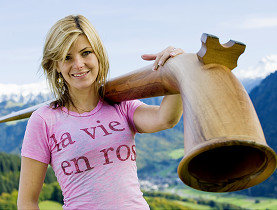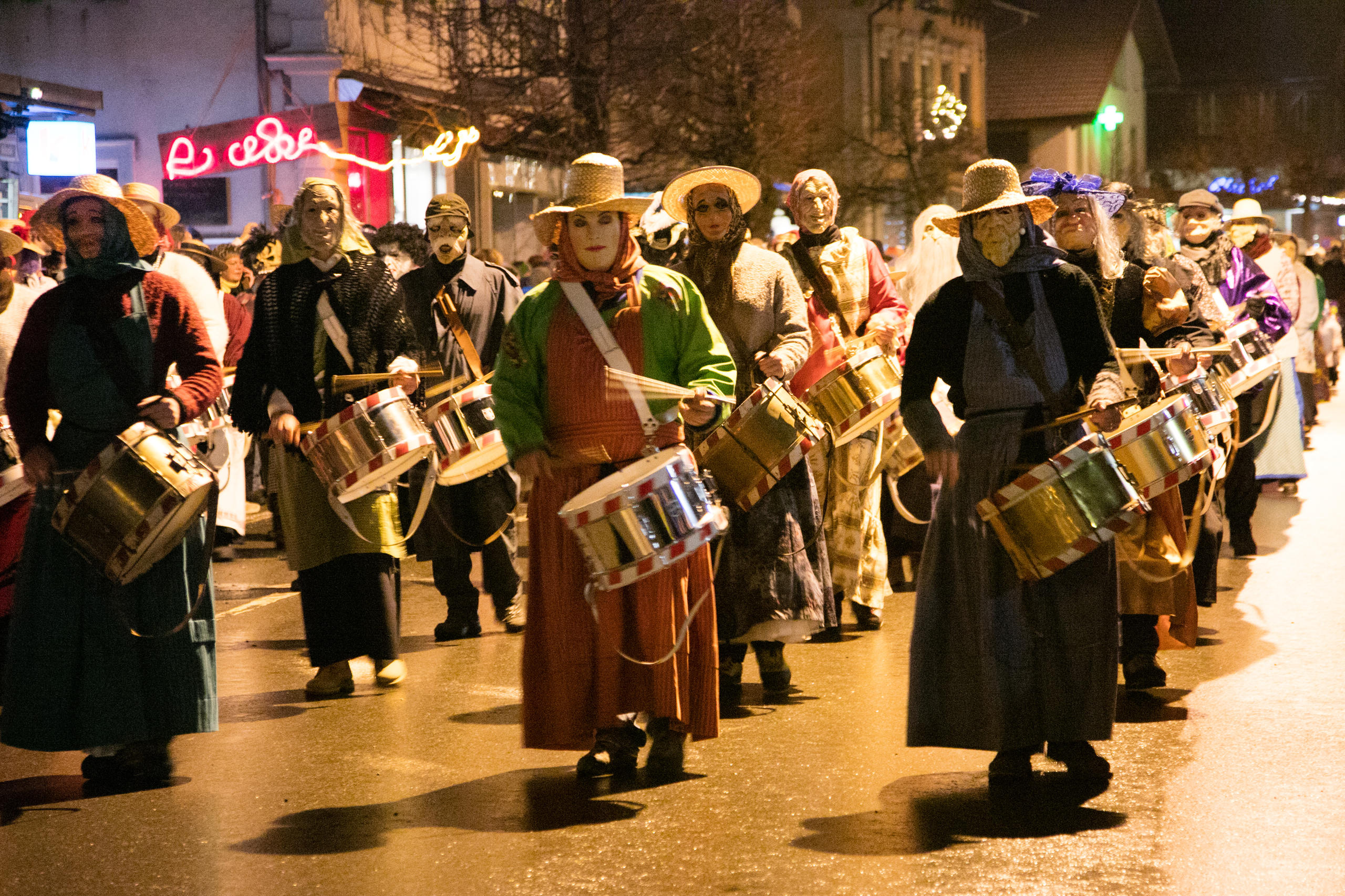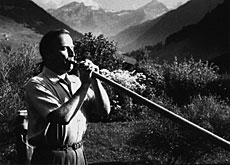Alphorn players break ranks to hit new notes

With her pierced nose and ripped jeans Eliana Burki is a symbol of anarchy in the Swiss alphorn scene.
The alphorn was used by shepherds in the 18th century to communicate across the Alps. Burki, aged 25 and from Bern, became fixated by the traditional instrument at the age of five and was performing in concerts alongside adults from the age of nine.
Daily practice allowed her to go beyond the 12-note range of most players and use the alphorn in a blues-funk-jazz style that is at odds with the more purist form. The result landed her a record deal and a chance to work with David Bowie producer David Richards.
“You can compare it to the punks of the 1970s. I feel like them,” she told swissinfo. “The instrument is difficult to play and I needed to practise for 20 years to develop this virtuosity. I take it to the limits but there are many more limits waiting for me.”
Burki is just one of the new wave of alphorn players who are experimenting with the instrument, trying to extend its purpose beyond a mere symbol of Switzerland.
The first tentative innovations started 40 years ago when Swiss musicians such as jazz player Hans Kennel started to explore the alphorn’s musical potential by combining it with other instruments, and Hans-Jurg Sommer developed groundbreaking compositions that later became standards.
Tourist attraction
“The alphorn was not necessarily considered an interesting instrument then. It was much more a symbol,” said Stefan Schwietert, a Swiss filmmaker who produced a 2003 documentary, Das Alphorn, on the movement.
He says popular culture in post-war Switzerland suffered as Europe bowed to a more influential “Americanisation” of culture. Traditional music was either strictly preserved or sentimentalized in television shows, and led many artists to lose touch with their roots.
“In Switzerland finally there was a generation that got beyond this huge wall that had been built and rediscovered that there were actually very strong, powerful traditions in alpine music. For example, big spontaneity in singing and improvisation,” Schwietert told swissinfo.
“Rediscovering that was something the younger generation could connect to. That’s why it slowly started in the 1970s and became a movement, where really a large number of musicians started to deal with this music again and pick it up and use it for their own artistic identity.”
Two camps
The alphorn was named the Swiss national instrument in 1827 by musicologist Joseph Fétis after centuries of use by herdsmen. But by that time it had almost disappeared from common usage and was seen mainly as a tourist attraction.
It was formally brought back into Swiss social life with the founding of the Federal Yodelling Association in 1910, which has organised alphorn blowing courses since 1921 and published traditional tunes and new compositions.
Although anyone can join the association, it introduced strict rules for musicians who want to perform in competitions. A dress code has to be followed and entrants cannot stray too far from the traditional alphorn folklore compositions.
Willi Michel, a player and yodeler from the Lauterbrunnen valley in the Bernese Oberland, tries to straddle the two camps.
He has played the alphorn since the age of 13 and started making the instruments himself. The shape of one particular piece of wood inspired him to fabric a square alphorn to see how it would sound. To his surprise the effect was the same as a rounded one.
Michel took the final product – now painted black and white instead of the usual wooden veneer – to a competition and during the unofficial second half took to the stage, to a stern response from the head of the local folklore society.
“He called me and said you had better put that alphorn away. That’s not the traditional way. We don’t like it,” Michel said.
But word had spread about his unusual alphorn and he was invited to perform with it on a televised music entertainment show. His appearance was the final straw for the Federal Yodelling Association who suggested it would be best if he turned in his membership.
“I said, that’s ok, that’s a good reason to leave the association. I don’t want to harm it. I am traditional but I am open to other influences,” he said.
“I think there is a lot more experimental stuff that can be done with the alphorn. I think change should happen but it should be related to tradition. The association doesn’t like it of course but they have to go with the flow, as with anything.”
Change in the air
But change is already in the air, according to Antje Burri of the Federal Yodelling Association.
The association turns 100 in 2010 and is coming up with a new logo and prospectus to attract people to, and inform them about, the three traditions they safeguard: alphorn blowing and flag and stone throwing.
“There are people who are interested in tradition. It’s a good thing, a great symbol for Switzerland,” Burri told swissinfo.
“The association is there to gather ideas, to be able to support and sustain the tradition in the future. But we are not closed in. People can get involved in modern music. It’s a personal choice.”
swissinfo, Jessica Dacey
The alphorn’s use varied between the 16th and 20th centuries, from a tool for herdsmen to communicate across neighbouring Alps and to call their cows back to the farm for milking. It was also played on summer nights in the Alps as a form of prayer in Protestant regions.
By the start of the 1800s the alphorn had more or less disappeared from herdsmen’s use, as individual dairies were increasingly being replaced by big co-operatives In 1805, the first herdsmen’s festival on the Unspunnen meadow near Interlaken aimed to boost a revival in alpine music but it failed, with just two candidates stepping up for the alphorn competition. At the 1808 herdsmen’s festival there was only one player.
Meanwhile, the instrument was gradually becoming known as a symbol of Switzerland and was attracting tourists. The Bernese governor Niklaus von Mülinen is attributed with ensuring the tradition did not die out completely by making the instruments in the 1820s and lending them to singers in Grindelwald, who were taught to use them in courses.
In 1827 the musicologist Joseph Fétis pronounced the alphorn the Swiss national instrument. It was formally brought back into Swiss social life with the founding of the Federal Yodelling Association in 1910, which has organised alphorn blowing courses since 1921 and published traditional tunes and new compositions. At today’s alphorn blowing competitions, players range from soloists to quartets and choirs.
After 1968 classical composers became more in contact with traditional instruments and in 1972 the first concerto for alphorn and symphony orchestra was composed by Jean Daetwyler. Jam sessions with jazz artists followed. At the beginning of the 1970s, the Federal Yodelling Association and its sub-unit, the traditional alphorn players, accepted the polyphonic playing of a piece entitled Alphorn-Fa and welcomed female candidates at competitions.
Professional musicians also started to do more experimental improvisations with the alphorn. Among them: Jürg Solothurnmann’s jazz band, the Alpine Jazz Herd, included an alphorn and jazz musician Hans Kennel and the three other members of the Contemporary Alphorn Orchestra converted the alphorn into an idiophone in scraping the rattan-windings with the mouthpiece.
It made a crossover to pop in 1977 when Eurovision entry Pep Lienard used an alphorn as part of his song, Swiss Lady.

In compliance with the JTI standards
More: SWI swissinfo.ch certified by the Journalism Trust Initiative












You can find an overview of ongoing debates with our journalists here . Please join us!
If you want to start a conversation about a topic raised in this article or want to report factual errors, email us at english@swissinfo.ch.